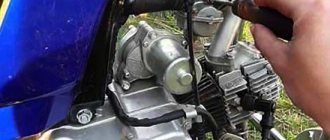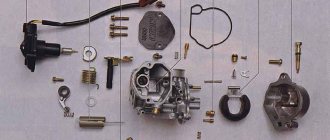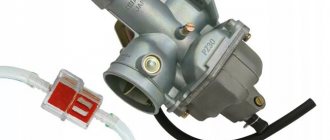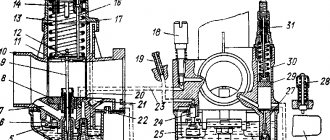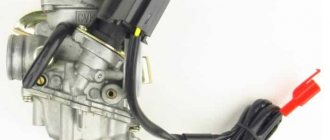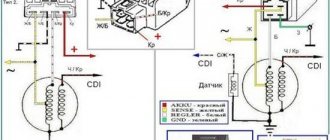What are jets in a carburetor?
Carburetor jets are calibrated holes inside the carburetor. Such elements can be made of various materials and differ in the diameter of the working hole.
Jets can be installed inside the carburetor cavity in various ways. Some elements are pressed inside a hole of a larger diameter. Thanks to this arrangement, it is possible to ensure greater resistance of products to increased levels of vibration. The disadvantage of this type of element is the more complex maintenance and repair process.
The jets may have threads on the outer surface, which allows these parts to be easily screwed into the carburetor body. The advantage of this design is that it simplifies repairs, including replacing faulty elements with new products.
What are the jets responsible for?
Jets are needed to supply fuel in a certain ratio. The carburetor has a large number of micro-channels through which air can also be supplied, which is necessary to fill various cavities when the fuel level in them decreases, as well as when preparing the fuel mixture.
Several jets are installed in the carburetor. The idle jet most often needs cleaning if low-quality gasoline is used or the fuel filter is not changed on time. The fuel consumption and engine response will depend on the correct adjustment of the jets, and if the jets are incorrectly selected with the wrong hole diameter, the engine may not start due to flooded spark plugs.
Given the importance of these elements, replacement products should be selected only taking into account the catalog number of the main part. For example, if Solex jets are needed for replacement, then you should buy and install only products for this type of carburetor. It is also necessary to take into account the designations from the set of numbers following the name of the dosing system (Solex 21073, Solex 21083, etc.).
Which jets are better
If it is possible to purchase products made of brass, then you should give preference to products made from this copper alloy. Brass is resistant to aggressive environments, so products made from it do not rust in the carburetor throughout its entire service life. Automotive fuel may contain a large number of additives that can have a negative effect on other types of materials. For this reason, you should not use homemade jets or try to replace these parts with any tubes that match the outer diameter.
Original carburetor jets are better than those purchased for replacement in various repair kits. For this reason, if it becomes necessary to replace one part, you should not install all elements of this type.
Messages [14]
1↑ Topic from 34region 03/05/2016 23:51:31
- 34region
- Newbie
- Inactive
- Registered: 13-09-2012
- Messages: 26
- Reputation: 2
Topic: Once again about constant vacuum carburetors (vacuum engines)
Installed on my Dnepr 11, Keihin VG 22 carburetors, with HONDA CBR600. Through trial and error, changing different filters, nuleviks, standard Dnieper, etc., I achieved the ideal mixture of spark plugs, just like in the book, brick-colored soot, excellent acceleration. 2nd gear 50 km/h, 3rd gear 95 km/h, 4th gear 120 km/h etc. two or three minutes and all the gasoline in the carbs runs out((((((jerks, dips, slowdowns begin. I reduce the speed to 70 km/h and drive for a couple of minutes at half throttle, and it starts accelerating again, and so on. I’ll say right away that it was installed by my relatives For 65 T carburetors. With the original air filter. And it goes 120 without problems for 15 - 20 minutes. I just didn’t accelerate further because it was blowing))). Now the question is: has anyone encountered a similar problem? How did you solve it?
2↑ Reply from Ghost Rider 03/06/2016 00:25:10
- Ghost Rider
- Ghost rider
- Inactive
- Name: Roman 34RUS
- From: Volgograd region. Krasny Yar.
- Registered: 15-01-2012
- Messages: 3 608
- Reputation: 108
- Motorcycle: M-72, Stels Skif 50 2T, VAZ 21113.
Re: Once again about constant vacuum carburetors (vacuum engines)
3↑ Reply from 34region 03/06/2016 00:27:54
- 34region
- Newbie
- Inactive
- Registered: 13-09-2012
- Messages: 26
- Reputation: 2
Re: Once again about constant vacuum carburetors (vacuum engines)
4↑ Reply from Sleepwalker 03/06/2016 03:31:47
- Sleepwalker
- Pro
- Inactive
- From: Dnepropetrovsk region
- Registered: 30-05-2014
- Messages: 975
- Reputation: 69
- Motorcycle: Dnepr MT-11
Re: Once again about constant vacuum carburetors (vacuum engines)
Stupid advice. but check the hoses and holes in the carbs themselves for the hole diameter. I once came across something in the car, there was some strange buildup in the fuel supply pipe, a defect or something, in general, from a hole with a diameter of
5-6mm left, maybe a millimeter and a half. and at high speeds there was similar garbage, then it stalls, then there is no traction ..
5↑ Reply from zundap 03/06/2016 06:20:59
- zundap
- Experienced
- Inactive
- Registered: 28-01-2013
- Messages: 358
- Reputation: 83
Re: Once again about constant vacuum carburetors (vacuum engines)
I encountered such a problem, but it manifested itself when there was little gas in the tank, about 1/3 I had to drive with a full tank, then I installed a fuel pump and everything became normal.
6↑ Reply from 34region 06-03-2016 13:20:32
- 34region
- Newbie
- Inactive
- Registered: 13-09-2012
- Messages: 26
- Reputation: 2
Re: Once again about constant vacuum carburetors (vacuum engines)
I drilled the holes in the fittings to 5mm, in the hoses 8mm, probably still needs a fuel pump. for them?
Added: 06-03-2016 09:20:32
I encountered such a problem, but it manifested itself when there was little gas in the tank, about 1/3 I had to drive with a full tank, then I installed a fuel pump and everything became normal.
Source of the article: https://forum.motoroad.ru/topic6873-eshche-raz-pro-karbyuratory-postoyannogo-razryazheniyavakuumniki.html
How to properly clean carburetor jets from plaque and dirt
If, while cleaning the jets, the basic standards for carrying out such an operation are violated, then significant deviations in engine operation are possible due to changes in the fuel dosage. The air jets of the Solex carburetor also need to be properly freed from dust contamination. It is also important to clean the lambda probe in a timely manner.
When setting up the carburetor metering system, superficial cleaning of the jets can be carried out. This method of removing contaminants will not take much time, but its use is only possible if there are relatively minor problems with the performance of this unit.
In case of significant contamination, a thorough cleaning of the jets is required, and if the performance of the products cannot be restored, then a new part is installed.
Surface cleaning of jets
Surface cleaning of jets can be carried out using special aerosols. A can of solvent will be inexpensive and can be easily found in specialized auto parts stores. The product has a long tube for supplying the active substance, which allows for precise spraying of liquid in the most economical way. The procedure for cleaning the jets of a Solex 21083 carburetor or other similar models is carried out in the following sequence:
- The air intake or air filter housing is removed (depending on the car model).
- The air and fuel jets of the main metering system are unscrewed (you need to remember the markings of the jets in order to correctly install them in place).
- The idle speed solenoid valve is removed.
- The aerosol is fed into the holes cleared of parts.
- Air and fuel jets are installed.
- The fuel choke lever is pulled out.
- The engine starts.
- A running engine warms up at idle and medium speeds.
- The engine turns off.
- The solenoid valve and air duct or filter housing are installed.
After connecting all the elements, start the engine again and check its operation in various modes.
Thorough cleaning of jets
If superficial cleaning of the jets did not bring a positive effect or the performance of the carburetor was restored only for a short time, then more thorough work will need to be done. In order to qualitatively restore the throughput of small parts, you will need to remove the carburetor from the car. This is not difficult to do, but first you need to disconnect the following elements:
- Air duct.
- Throttle rod or cable of the gas pedal.
- Control cable for the fuel suction system.
- Fuel hose.
- Solenoid valve wire.
Next, remove the carburetor from the intake pipe. In the carburetor, unscrew all the screws holding the lower part of the product. The device is disassembled into 2 halves. All internal jets are unscrewed and washed in acetone, and also blown with compressed air. In order not to confuse parts of similar size, they can be placed in plastic containers with inscriptions. The internal channels and fuel chamber are also thoroughly washed with solvent.
When the jets are dry, they are installed in place, the carburetor is assembled and installed on the inlet pipe. After connecting the controls, air supply and power, the engine is started and its operation is checked in various modes.
Throttle valve
The throttle valve is a carburetor control element connected to the gas control via a flexible connection.
It regulates the flow area of the diffuser, moving perpendicular to the axis of the main air channel. In many carburetor models, the throttle valve is a cylinder that moves on a sliding fit inside the carburetor body. Even in carburetors with a constant vacuum (in the literature there is a term - with a constant flow rate), in which the throttle valve performs rotational movements, there is a valve that regulates the cross-section by moving perpendicular to the axis of the diffuser. The design and operating principle of such carburetors will be discussed later, since their features deserve a separate section.
Butterfly valves are classified according to their shape into cylindrical and flat (they are also called gate valves - the term is appropriate, since in accordance with GOST 24856-2014 “Pipeline fittings. Terms and definitions”, a gate valve is defined as “a parallel valve in which the locking element is made in plate form"). The figure below shows a comparison of the sizes of round and flat dampers. A flat throttle body creates less parasitic turbulence underneath by reducing the length of the diffuser.
General view of round and flat throttle valves. The guide holes for the dosing needles in the center of the flaps are highlighted in color.
The following figure shows the difference in the lengths of the main air passages when using a round and flat damper. It can be seen that a carburetor with a flat throttle body has a shorter channel, which means there is less resistance to air flow.
Comparison of the lengths of the main air channels with cylindrical and flat dampers
The diffusers of modern carburetors are carefully designed to reduce parasitic turbulence at the junction of the throttle valve and the carburetor body. For example, in the figure below under the letter a
shows a Dellorto carburetor of the VHSD series (For example, the designation PH in the Dellorto carburetor series stands for P (Piston) - cylindrical throttle valve, H (Horizontal) - horizontal orientation of the longitudinal axis of the main air channel. The letter V (Valve) in the names of other lines (for example VHSD ) indicates the presence of a flat throttle valve), in the diffuser of which two thin guide grooves are visible along which the throttle valve moves, like a guillotine.
And in the picture under the letter b
the VHSB series carburetor throttle valve is demonstrated, installed in a special “cup”, which serves as a guide for its movement. The damper assembly with the cup is installed in a cylindrical seat of the carburetor body.
a - guides for moving the throttle valve, b - guide cup for the throttle valve.
The throttle valve of carburetors with a metering needle, both flat and cylindrical, has a bevel, which affects mixture formation at low throttle lifts. A low-ramp choke will richen the mixture up to 1/4 throttle lift, but if the mixture is too rich, a high-ramp choke can be used. It should be borne in mind that even a small change in this adjustment parameter can significantly affect mixture formation.
Throttle valves with different bevels
Replacing carburetor jets
If earlier during operation of the machine the rules for cleaning the jets were grossly violated, then the parts will need to be replaced. For example, if the owner of a car used metal wire or needles to clear calibrated holes from contamination, the diameter of the product could increase. If such a problem occurs on the fuel nozzle, then the engine will be filled with gasoline, and on the air nozzle, the car will run on a lean mixture. Both situations will not allow you to comfortably operate the vehicle, so you will have to replace damaged parts.
Sometimes, installation of a new carburetor jet is required as a result of the loss of an element during cleaning. For example, if a powerful compressor unit was used to blow through the product, the part may fly out a considerable distance if it was not properly fixed during the work.
To replace the jets you will need to buy a new repair kit. Then you should disassemble the carburetor, as when performing a thorough cleaning, unscrew the old ones and install new elements.
Options for modification and selection of jets on Solex carburetors
The Solex 21083 carburetor jets can be modified to change the dynamic and economic performance of the engine. A feature of such work is the need to change only fuel or only air dosing elements. If you need to increase power, then it is enough to slightly increase the diameter of the fuel elements; to increase engine efficiency, a similar operation is carried out with air jets.
Increasing the diameter by drilling is possible, but given the large error when performing such an operation, it is recommended to select a part with the required size from the jet table.
Motorcycle-type carburetors with constant vacuum at the nozzle
Hello, dear readers. Today we are going to present the final part of the article devoted to motorcycle-type carburetors.
In this final publication, we will look at the features of carburetors for four-stroke small-displacement engines.
At the end of the post you will find links to the PDF version of the article. The PDF version includes all 6 parts published here separately. Save it in your library and forward it to those interested.
In addition, at the end there is a list of references and the author’s final words on the series of publications “Motorcycle-type carburetors”.
Solex 21083 carburetor jet table
You should study the jet table at the very beginning of work to improve the car’s fuel system. For the DAAZ Solex 21083 carburetor, the diameter and catalog number of the fuel jets will be as follows.
| Carburetor models | 1st camera | 2nd camera |
| 21083-1107010 | 95 | 97,5 |
| 21083-1107010-31 | 95 | 100 |
| 21083-1107010-35 | 95 | 100 |
| 21083-1107010-62 | 80 | 100 |
The following products can be used as air jets when selecting a new part.
| Carburetor models | 1st camera | 2nd camera |
| 21083-1107010 | 155 | 125 |
| 21083-1107010-31 | 155 | 125 |
| 21083-1107010-35 | 150 | 125 |
| 21083-1107010-62 | 165 | 125 |
Fuel jets xx (idle):
| Carburetor models | 1st camera | 2nd camera |
| 21083-1107010 | 39-44 | — |
| 21083-1107010-31 | 38-44 | — |
| 21083-1107010-35 | 38-44 | — |
| 21083-1107010-62 | 50 | — |
Knowing the catalog number of the carburetor, it is easy to compare the parts with each other and choose the most suitable jet for tuning.
What is the difference between modifications 21081 and 21083
The modifications of the Solex 21081 and Solex 21083 carburetors are almost identical. In devices for preparing the working mixture, only the diameters of the nozzles and the operating principle of the fuel suction system differ slightly. The Solex 21081 carburetor has a semi-automatic device for starting the engine, while the Solex 21083 has a mechanical device controlled by a button.
The differences in the throughput of the jets are due to the difference in the working volumes of the engines 21081 and 21083.
Jet table for comparing calibration data for Solex 21081 and 21083 carburetors
The table shows calibration data for Solex 21081 and Solex 21083 carburetors.
| Options | 21081-1107010 | 21083-1107010 | ||
| First camera | Second camera | First camera | Second camera | |
| Diffuser diameter, mm | 21 | 23 | 21 | 23 |
| Fuel jet GDS | 95 | 97.5 | 95 | 97.5 |
| Air jet GDS | 165 | 135 | 155 | 125 |
| Emulsion tube | 23 | ZC | 23 | ZC |
| Fuel jet CXX | 39-44 | — | 39-44 | — |
| Air jet CXX | 170 | — | 170 | — |
| Fuel nozzle of the transition system of the 2nd chamber | — | 50 | — | 50 |
| Air jet of the transition system of the 2nd chamber | — | 120 | — | 120 |
| Econostat fuel jet | — | 70 | — | |
| Economizer fuel jet | 40 | — | 40 | — |
| Acceleration pump nozzle | 35 | 40 | 35 | 40 |
Adjusting the Solex 21083 carburetor
Cleaning the internal parts of the carburetor and the correct selection of products according to the diameter of the nozzle holes does not yet guarantee stable engine operation. Setting up the carburetor is a mandatory procedure after performing any type of work related to disassembling the product. The procedure for adjusting the Solex 21083 carburetor consists of setting the optimal fuel level in the float chamber, the idle speed and tightening the mixture quality adjustment screw.
Fuel level in the Solex 21083 carburetor
To adjust the fuel level in the float chamber, you will need to disassemble the carburetor, so it is advisable to combine this procedure with a complete cleaning of the jets (you do not need to remove the device from the inlet pipe, but only dismantle the upper part of the product). The float chamber is filled automatically. The needle valve that closes the fuel hole is mechanically connected to a float, which lowers when the gasoline level decreases. To ensure that there is always a sufficient level of fuel in the float chamber to ensure non-stop operation of the engine, as well as to eliminate the possibility of overflow, the opening moment of the valve is set by adjusting the position of the float relative to the body of the top cover of the Solex carburetor.
To perform adjustment work, you will need to prepare the following tools:
- A small piece of wire (diameter 1 mm).
- Calipers.
- Ruler.
If the carburetor is not disassembled, then you should remove the top cover of the product by first unscrewing 5 screws. The part separated from the main body should be placed on a flat, hard surface with the floats facing up.
At the next stage, the parallelism of the floats relative to the side imprint on the gasket is established. If the lines diverge, then carefully bend the hollow element so that along the entire length of the product there is an equal distance between the control strip and the float.
Set a 1 mm gap between the floats and the top cover. For this purpose, it is necessary to place a control wire between the hollow product and the gasket of the carburetor top cover. If the distance is greater or less, then the correct interval should be set. The easiest way to set the gap is the following method:
- Extend the depth gauge of the caliper to 34 mm.
- Place the depth gauge on the carburetor top cover gasket parallel to the float.
- Bend the lever or tongue on which the needle valve rests so that the top of the float is at a distance of 34 mm from the top carburetor cover.
Using a ruler, you should also check the maximum lift relative to the top cover (or the lowering of the float when this part is in normal operation). For this purpose, it is enough to install the measuring tool parallel to the float. The maximum distance between the float and the top cover should be 25 mm.
After performing adjustment work for one float, the operation is repeated on the second element. Then the carburetor is assembled and the operation of this part is checked. If, after correct adjustment, the engine is filled with fuel again, you should check the functionality of the needle valve. If this element does not block the fuel nozzle, it should be replaced.
Basic operating modes of the carburetor
When the carburetor jets of the VAZ 2109 - 2108 are replaced or cleaned of contaminants, the idle speed will need to be adjusted. In order for air to enter the combustion chamber in the required quantity to prepare the fuel mixture, you should adjust the damper screw to set its opening gap to 2.5 mm (you can also use a wire or drill of the appropriate diameter, which is placed between the moving element and the carburetor body).
Adjusting the idle speed of a VAZ 2108 or 2109 is carried out as follows:
- The engine warms up to a temperature of 90˚C.
- The fuel choke valve opens completely.
- By rotating the “quantity” screw, engine operation is set at a frequency of 750 - 800 rpm (checked with a tachometer).
If it is not possible to set the idle speed within the specified limits, then you should enrich or lean the mixture using the “quality” screw. To set accurate values, you need to use the “quantity” screw to increase the speed to 900 rpm, and by screwing in the “quality” screw, reduce this figure to 800 rpm.
When performing work on setting up the Solex 21083 carburetor, you should also check the serviceability of the accelerator pump, which supplies an additional portion of fuel to the carburetor when the throttle valve is sharply opened. You should also make sure that the shutter of the second chamber moves freely when the first shutter is fully open. Only with the correct settings of these elements can you achieve stable operation of the carburetor at idle and excellent dynamic performance when accelerating the car.
Lada 2107 Emmanuel › Logbook › Under the hood, part 11: “Refinement of the DAAZ-2107 carburetor”
Looking ahead, we decided to write about our modification of the carburetor, although it has not been fully tested due to the forced capital...
It all started with the fact that it was decided to convert the vacuum drive for opening the second chamber into a mechanical one (here), which immediately gave the result, it became easier to accelerate to hundreds. According to measurements with a friend, it turned out to be 13.4 seconds. up to a hundred

